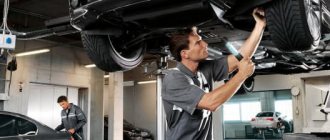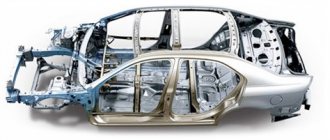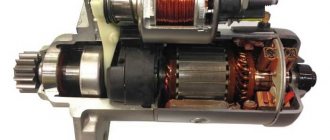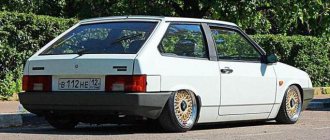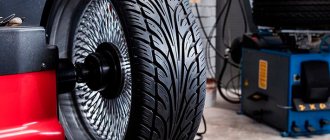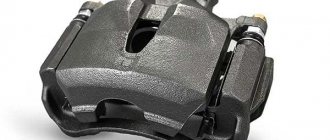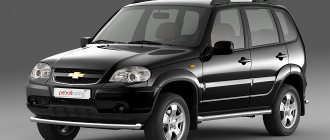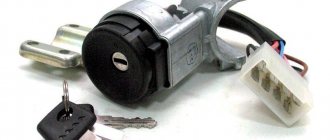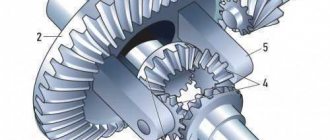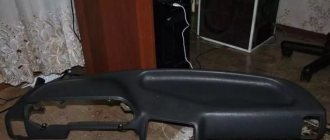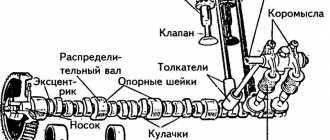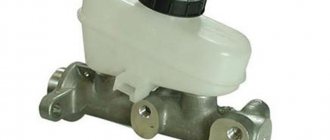Not only comfortable driving, but also the safety of the driver and nearby passengers depends on the general technical condition of the vehicle’s chassis parts. Among the many elements, the front wheel hub deserves special attention.
The front wheel hub is a component of the vehicle's chassis that performs several functions. The driver needs to know not only how to replace the low beam bulb, but also how to troubleshoot such a hub. If this part fails, the vehicle will not be able to move.
To prevent this, the driver must regularly check the condition of the hubs, organize car maintenance, and promptly contact a special service to repair even the most minor damage to the part. To independently check the operation of the hub, you need to know the features of the device and the functional purpose of the element.
Purpose of the front wheel hub
To understand what a hub is, it is worth understanding its main functional purpose. To do this, it is not at all necessary to have special knowledge of the general structure of vehicles.
The hub is a special part that allows the wheel to rotate. To do this, it must be mounted as securely as possible on the axle shaft. A disc is screwed onto the hub, and its design itself has a pair of rotating bearings. This structural element has quite a lot of functions. Here are the most basic ones.
- The main task of the hub is a movable and at the same time reliable connection of the wheel disk to the steering knuckle axis.
- Ensuring high-quality braking and reliability of the entire braking system as a whole. The reason is that the brake disc is also fixed to the hub.
- In front-wheel drive vehicles, the hub transmits rotational motion to the wheels in the direction of the axle shaft. For this purpose, there is a special internal hole with slots inside, into which one end of the axle shaft enters during movement. This allows the car to move freely along the track.
A modern car has a whole system of electronic sensors that allow it to constantly receive a huge amount of information and ensure the safest movement of the car. The front wheel hub plays an important role in this complex process.
Types of hubs and features of their attachment to the wheel
Each hub has common design features, which are based on a bearing that converts the sliding force into the same rolling force.
According to the method of attachment to the wheel, axle shaft, as well as the trajectory of the load and, accordingly, the transfer of load to the suspension, they are divided into the following categories:
- Radial, classic, when the element can only perceive torque.
- Thrust, when a locking nut is placed on the bearing, which prevents the free movement of the product.
- Radial-thrust and thrust-radial hubs are combined action hubs, most often installed on modern cars from foreign manufacturers.
The hub is fixed to the wheel through the calculated number of studs, followed by tightening with nuts.
The stud itself, in turn, is attached to the flange, along with the brake disc, and it is already mated through a movable connection with a bearing installed in the body of the hub. If older car models have drum brakes, they are also attached to a flange that is driven as the wheels rotate.
Repair parts
The hub is one of the most important parts in the chassis of a car, without which its operation would be impossible. That is why car enthusiasts need to order its diagnostics on each wheel during vehicle maintenance.
This is due to the fact that early detection of a defect will help prevent serious consequences associated with expensive repairs and save the driver from unnecessary expenses. In addition, even if the product is in order, then during a banal oil change in the engine, these parts also need to be lubricated regularly, increasing their service life.
Hub design
It is necessary to know the structure of the front wheel hub in order to detect and eliminate possible malfunctions. Despite its relatively complex functional purpose, the element has a fairly simple internal structure. Among the main parts of this unit are:
- hub body;
- bearings;
- wheel studs;
- special sensors.
The hub body is a durable cast part made of a special alloy and processed with turning tools.
This element must be considered as a single complex having bearings and studs. For the majority of manufacturers, these elements are only included as a set; they are inseparable from each other.
Such solidity is able to ensure the maximum level of reliability and safety of the entire chassis of the vehicle.
Signs of a malfunction in the hub
The driver will be able to identify certain malfunctions in the operation of the vehicle’s chassis system based on such characteristic features as:
- uneven wear of installed tire treads;
- significant body sway when performing standard braking or turning;
- frequently repeated deviation of the vehicle from a straight line;
- compression and leakage of shock absorbers;
- high level of vibration produced;
- the appearance of various extraneous sounds that constantly accompany the movement of the machine.
Despite the clear audibility of extraneous sounds, the driver will not be able to determine by ear which part of the element the problem has arisen.
If you detect a suspicious sound, you should immediately jack up the vehicle and try to manually spin the front wheels.
This is interesting: Which engine is better to take the Audi 100 with?
When performing this manipulation, you should carefully study the appearance of the wheels. One of the common manifestations of hub failure is increased wear of the rubber. This is caused by a strong vibration that radiates into the steering wheel, with simultaneous heating of the brake disc, which occurs due to an improperly rotating bearing.
The heating of the disk can be felt by simply placing your hand on it after traveling 8 - 10 km. If the hub is faulty, the temperature of this element exceeds 70 degrees.
Similar symptoms may characterize such a phenomenon as failure of the hub bearings.
To determine which side the hub has broken, it is not necessary to stop and lift the car. It will be enough to pay attention to the degree of hum produced while turning the steering wheel. When turning right, the noise will increase in the left wheel, when turning left, the sound will come from the right side.
How to check a wheel bearing
If the rear wheel bearing of a VAZ-2108 breaks down, you will hear a characteristic howl coming from the trunk. Try to listen to which direction the sound is coming from. This will allow you to reduce the time spent searching for a faulty bearing. To make a diagnosis, you need to lift the wheel and then rotate it by hand.
If the bearing is in good condition, there will be no noise. The wheel should rotate without jamming. But if the bearing is faulty, then a strong noise will appear, as well as a metallic sound, as if the balls inside the bearing are rolling. The louder the noise, the greater the wear on the wheel bearing. It is advisable to replace both sides at once, this will improve the efficiency of the repair.
Causes of malfunctions in the hub
There are quite a lot of reasons for hub failure. Among the most common causes of failure are the following common factors:
- Wear of individual system elements.
- Errors in wheel alignment adjustment.
- Incorrect mounting of shock absorbers.
- Heavy long-term loads on the front wheels.
Since there may be several breakdowns, it will be quite difficult to determine the exact cause. However, it is simply impossible not to notice it. Without exception, all malfunctions are very noticeable. You cannot ignore the constant noise or hum that appears, the intensity of which varies in direct proportion to the speed limit or the strength of the braking performed.
If the problems listed above occur, you need to urgently repair the front wheel hub. Depending on the complexity of the situation, repair work may involve simply adjusting the fastening of bearings, bolts or nuts. In other cases, a complete replacement of the hub may be required, when the help of professionals is indispensable.
You can carry out repair work yourself only if you have certain knowledge and special tools. Below you can study the instructions for carrying out repair work. It tells how to check the fastening and how to replace the special rotary cap.
ABS system and bearings
For cars with ABS, you have to choose special bearings with a magnetic sensor ring, which is necessary for the sensor to operate and perform the braking task. Moreover, the parts have identical dimensions and even service life. Instead of a ring, cheap bearings have a gear.
Products with magnetic rings are very lightweight, easy to install and work great even when the car is moving at low speeds. The only drawback is their price. Without special bearings, ABS simply will not work.
Hub repair and replacement
When carrying out a process such as replacing the front wheel hub, special attention is paid to preparatory work.
Preparing tools
First of all, you will need to prepare the necessary tools for this. In most cases, a regular set of special wrenches with heads is sufficient. At the same time, you need to prepare the following tools:
- Retaining ring remover.
- Special cup puller.
- Vise.
- Screwdrivers.
- Jack.
- Chisel.
- Hammers.
In addition to the jack, it is worth preparing special devices for fixing the car in a stable position. These can be all possible bars and supports. You will also need to purchase new parts if replacement is being done. You need to buy the entire set of hubs or bearings, it all depends on the degree of wear.
Preparing the machine
After carrying out the preparatory work, collecting all the necessary tools and materials, you can begin to replace the failed elements.
It is necessary to “jack up” the car in the right direction, depending on which side the replacement will be made from. To provide additional insurance, it is recommended to install special supports, for example, placing car anti-roll supports under the rear wheels.
Preparing parts
Next, the first gear is set at the gearbox; if it is a manual gear, the car is put on the handbrake. Using a special wrench, the wheel bolts and wheel bearing nut are unscrewed. If the car has light alloy wheels, you will have to remove the wheel, then apply the brake and completely unscrew the hub nut.
Quite often, drivers are faced with a situation where the hub nut is very tightly tightened and it is impossible to remove it with a wrench. In this case, you can use the method of drilling through one side of the nut that is stuck. This will allow you to drill out the edge of the part all the way to the thread. Then all that remains is to open the part with a blunt chisel and unscrew it easily and simply.
This is interesting: Do-it-yourself starting device for a car: 4 working ROM circuits
After completing such measures, you will need to remove the front wheel and remove the protective cap using a screwdriver. Next, the caliper is removed from the brake disc and moved to the side. For this purpose, the drum together with the stand must be turned towards you and the fasteners unscrewed. After this, the steering, ball joints and ends are removed.
Before starting such work, parts should be treated with a special substance designed to remove rust. This will greatly facilitate the operation associated with unscrewing bolts and nuts.
To remove the brake disc, you will need to unscrew the two bolts built into the hub and then do the same with the nut located in the center. This can be done using a wrench or a chisel, it all depends on how tightly the part is screwed on. Once the strut is completely unscrewed, you can remove the hub and begin repair work.
Three options for repair work
In most cases, one of the hub bearings fails, so the main repair work will be based on its replacement. There can be three main ways and options of action:
- The first method is based on replacing the part using a puller, but the steering knuckle is not removed.
- The second option will require its dismantling, after which the bearing will be changed on an installed workbench.
- The third method involves removing the entire rack. The bearing is replaced using a vice.
Each option has its positive and negative sides.
The positive side of using the first option is that there is no need to remove the adjustment bolt for a system such as wheel alignment. At the same time, the entire work process will not be very convenient, especially if there is no lift or special pit. For this reason, it will be quite difficult to knock out the hub and completely press the bearing.
It will be much easier and simpler to carry out the replacement using the second method. But there is a risk of disrupting the vehicle’s camber adjustment. In this case, before unscrewing the steering knuckle bolts, you will need to note its original position in the rack and at the same time pay attention to the position of the bolt that performs the adjusting function. This will help to avoid errors and errors during reassembly.
The second replacement option is ideal for those who are engaged not only in replacing the bearing, but also all the chassis elements - steering ends, ball joints and silent blocks.
The most difficult replacement option is the third method. Here, in order to remove the rack, you will need to completely unpress the steering tip and unscrew the fastening of the upper support. After this, it will be possible to replace the failed element.
During the replacement process, you need to pay attention to removing/knocking out the hub and its parts. These activities must be carried out very carefully. This will avoid any damage to the socket and the general structure of the mechanism. If the part cannot be reached by hand, the work can be done on a special pressing machine. In this case, you need to try to leave the installed corkscrew ring intact, which is not always included with the new hub.
When dismantling a bearing, do not expect it to remain intact. These elements are almost always destroyed. This needs to be taken into account.
Types of wheel bearings
Modern foreign cars no longer use serviceable bearings of outdated models (the so-called zero-generation bearings), which require adjustment and lubrication. Their place was taken by double-row bearings of the HUB-I type (first generation), which can be replaced separately from the hub.
HUB-I bearings
The second generation is HUB-II bearings, the outer race of which is equipped with a flange with mounting holes, and with its help the bearings are fixed to the suspension elements.
HUB-II bearings with rotation along the inner (left) and outer ring (right).
The most modern option is the third generation hub bearing HUB-III, which is an assembled hub unit in which the bearing is protected from external influences, has minimal radial runout and deviations from linear dimensions. The surface of the hub itself is used as one of the sides of the race (rolling surfaces) in HUB-III bearings, which further reduces the weight of the entire structure.
HUB-III hub units for drive (left) and driven wheels (right)
Bearings of the second and third generations are equipped with cassette seals, which allow gases to escape from the working cavity, but do not allow moisture and dirt to enter.
The fourth generation HUB-IV hub units are combined with CV joints, and the fifth generation designs are combined with brake discs. Such solutions have not yet been widely implemented, being in the development and testing stage.
